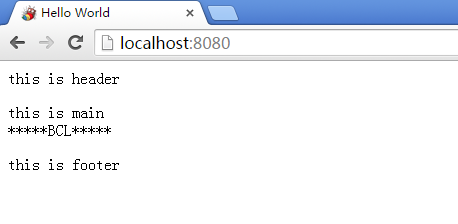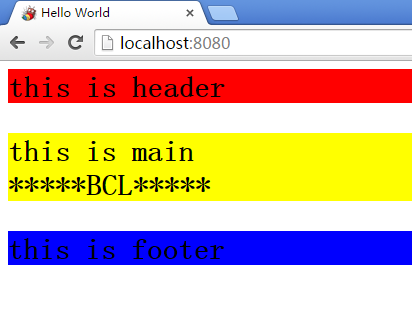建网站不可避免的要使用各种各样的静态资源,这一节,就来看看,如何加载css,js图片等等这些资源。
在之前的基础上构造一简单的个HTML的测试文件
<HTML> <head> <title>Hello World</title> <link href="static/core.css" type="text/css" rel="stylesheet" /> </head> <body> <div id="header"> <p>this is header</p> </div> <div id="main"> <p> this is main<br /> {{.Name | showname}} </p> </div> <div id="footer"> <p>this is footer</p> </div> </body> </HTML>再创建一个css文件:
* { font-size: 30px; font-weight: bold; }
#header { background-color: red }
#main { background-color: yellow; }
#footer { background-color: blue; }然后运行之前的go文件,结果如下:

从运行结果来看,会发现css并没有起作用,我们来看一看为什么会这样:
先做一个简单的测试:
我们之前在main方法中注册了一个路由:
http.HandleFunc("/", Index)我们期望的是当直接访问 http://localhost:8080 时就能转到index.html
页面。
但事实上呢?
我们来试一试这个地址:
http://localhost:8080/core.css
同样的得到的是index.html这个页面的内容,
也就是说我们注册的路由也匹配到了/core.css这个请求
问题出在哪里呢?
我们得自己写一个路由函数,来看看是如何匹配路由的:
先看一下go的文档:看看ListenAndServe函数的声明:
func ListenAndServe(addr string, handler Handler) error如果要自己写路由函数的话,就得先实现Handler这个接口,声明如下:
type Handler interface { ServeHTTP(ResponseWriter, *Request) }先声明一个结构体:
type MyMux struct { routers map[string]func(http.ResponseWriter,*http.Request) }实现ServeHTTP方法:
func (p *MyMux) ServeHTTP(w http.ResponseWriter, r *http.Request) {
//遍历routers,寻找匹配的path
for path, f := range p.routers {
if r.URL.Path == path {
f(w, r)
return
}
}
fmt.Fprintf(w, "Error: Don't match URL '%s'", r.URL.Path)
}重写main函数:
func main() {
mux := &MyMux{}
mux.routers = make(map[string]func(http.ResponseWriter, *http.Request))
mux.routers["/"] = Index
err := http.ListenAndServe(":8080", mux)
if err != nil {
fmt.Println("Error: ", err)
}
}这样的话对于每一次的请求,都遍历一次mux.routers,来查找是否有匹配到的路由,
但很显然,如果使用 “r.URL.Path == path” 这样的方式,是没法满足要求的,
因为你得列出每一种可能出现的path,这明显是不现实的,我们接下来考虑使用正则表达式来匹配路由规则。
我们需要重新实现ServeHTTP方法,但也只需要修改if的判断条件即可:
但不要忘了导入regexp正则表达式包
if ok, _ :=regexp.MatchString("^" + path + "$", r.URL.Path); ok { f(w, r) return }并且新增一条是用正则表达式的路由:
mux.routers["/static/.+"] = Static接下来,我们就要针对匹配到的static文件中的文件做单独的处理
func Static(w http.ResponseWriter, r *http.Request) {
fmt.Println("Deal Static: ", r.URL.Path)
w.Header().Set("Content-Type", "text/css")
http.ServeFile(w, r, "." + r.URL.Path)
}现在再通过浏览器分别访问一下URL:
http://localhost:8080/
http://localhost:8080/static/core.css
发现已经匹配正常了。
虽然丑了点,但不要在意那么多细节啦,只是用来演示一下。
当我们访问 http://localhost:8080/ 的时候,浏览器会向服务器发送一个GET /static/core.css
的请求,服务器会匹配到 /static/.+ 这条规则,然后调用func Static()函数,那么在该函数中的
r.URL.Path则是/static/core.css,如果/static目录下还有多个文件夹的话,还要对r.URL.Path的值
另作处理,这里就不在展开说明了。
此时,当我们访问 http://localhost:8080/ 的时候,就会发现页面解析正常了,效果如下:

同理,js和图片以及其他静态资源都可以按照上面的方法处理。
有疑问加站长微信联系(非本文作者)







